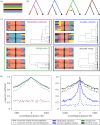Population genomics perspectives on convergent adaptation
- PMID: 31154979
- PMCID: PMC6560269
- DOI: 10.1098/rstb.2018.0236
Population genomics perspectives on convergent adaptation
Abstract
Convergent adaptation is the independent evolution of similar traits conferring a fitness advantage in two or more lineages. Cases of convergent adaptation inform our ideas about the ecological and molecular basis of adaptation. In judging the degree to which putative cases of convergent adaptation provide an independent replication of the process of adaptation, it is necessary to establish the degree to which the evolutionary change is unexpected under null models and to show that selection has repeatedly, independently driven these changes. Here, we discuss the issues that arise from these questions particularly for closely related populations, where gene flow and standing variation add additional layers of complexity. We outline a conceptual framework to guide intuition as to the extent to which evolutionary change represents the independent gain of information owing to selection and show that this is a measure of how surprised we should be by convergence. Additionally, we summarize the ways population and quantitative genetics and genomics may help us address questions related to convergent adaptation, as well as open new questions and avenues of research. This article is part of the theme issue 'Convergent evolution in the genomics era: new insights and directions'.
Keywords: adaptation; convergence; convergent adaptation; information theory; population genomics.
Conflict of interest statement
We declare we have no competing interests.
Figures


References
-
- Harvey PH, Pagel MD. 1991. The comparative method in evolutionary biology, p. 239 Oxford, UK: Oxford University Press.
-
- Martin A, Orgogozo V. 2013. The loci of repeated evolution: a catalog of genetic hotspots of phenotypic variation. Evolution 67, 1235–1250. - PubMed
-
- Rosenblum EB, Parent CE, Brandt EE. 2014. The molecular basis of phenotypic convergence. Annu. Rev. Ecol. Evol. Syst. 45, 203–226. (10.1146/annurev-ecolsys-120213-091851) - DOI

